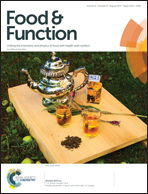Enhancement of the solubility and antioxidant capacity of α-linolenic acid using an oil in water microemulsion†
Abstract
The applications of α-linolenic acid (ALA) in the food industry are restricted due to its poor water solubility and antioxidant stability. This study concentrates on developing an ALA-loaded microemulsion (ALA-ME) to enhance its solubility and antioxidant capacity. The formulation of the microemulsion was investigated based on pseudoternary phase diagrams. The ALA-ME was characterized by using electrical conductivity, viscosity and transmission electron microscopy (TEM). The microstructure of the ALA-ME was probed using nuclear magnetic resonance (1H-NMR). The results proved that ALA-ME consisted of spheroidal droplets with 20–40 nm diameter. A structural transformation from water in oil (W/O) to oil in water (O/W) occurred, as seen from the electrical conductivity determination. The 1H-NMR results revealed a transition of the ALA position encapsulated from the core area of the microemulsion to the lipophilic layer of the surfactant. Furthermore, two microstructural models of ALA-ME were proposed. The antioxidant evaluation demonstrated that the ALA antioxidant capacity in microemulsions was enhanced to about 80% compared with that of ALA in oil solution.



 Please wait while we load your content...
Please wait while we load your content...